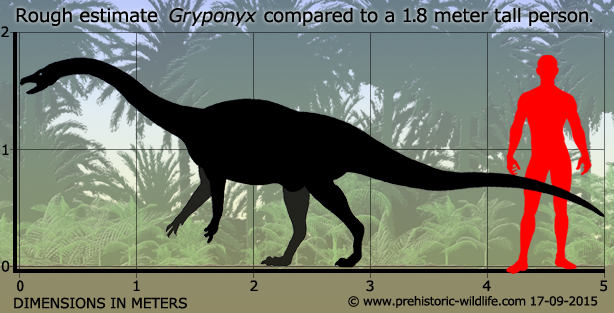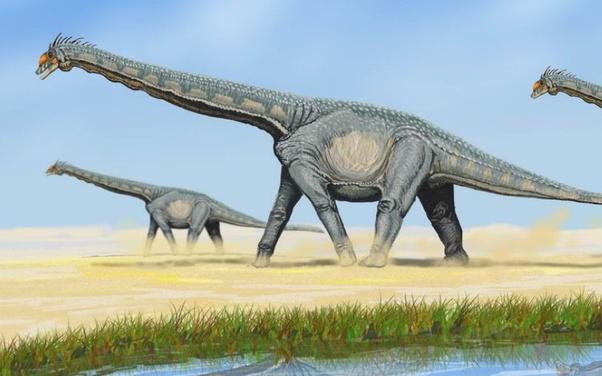|
|
Post by Talira Greycrest on Sept 17, 2024 7:41:47 GMT
Name: GraciliraptorPronunciation: Gray-sil-e-rap-tor Meaning of name: "Graceful thief" Species: G. lujiatunensisSize: Estimated to have measured around 1 metre long and weighing between 1 and 2kgs. Family: Dromaeosauridae Diet: Carnivore First fossils found: Known only from a single, fragmentary skeleton comprising of a partial upper jaw with some teeth, nearly complete fore and hind legs and ten partial tail vertebrae, discovered in the Yixian Formation of Liaoning Province, northeastern China. Named by Chinese palaeontologists, Xu Xing and Wang Xiaoling, in 2004. Lived: 126 million years ago during the Hauterivian stage of the Early Cretaceous in what is now northeastern China. 
|
|
|
|
Post by Talira Greycrest on Sept 18, 2024 7:20:34 GMT
Name: BellusaurusPronunciation: Bel-lu-sore-us Meaning of name: "Beautiful lizard" Species: B. suiSize: Full adult size uncertain as the only known fossils are thought to belong to juveniles. Family: Mamenchisauridae Diet: Herbivore First fossils found: Known from at least seventeen partial skeletons discovered in the Shishugou Formation of northwestern China. Named by Chinese palaeontologist, Dong Zhiming, in 1990. A lack of fusion in some of the bones suggests these animals were juveniles that may have been killed in a flash flood. It's also led to speculation that Bellusaurus may actually be the juvenile form of Klamelisaurus.Lived: 170 million years ago during the Bajocian stage of the Middle Jurassic in what is now northwestern China. 
|
|
|
|
Post by Talira Greycrest on Sept 19, 2024 10:32:17 GMT
Name: TatisaurusPronunciation: Ta-ti-sore-us Meaning of name: "Da di lizard", after the Chinese village near where its fossils were discovered. Species: T. oehleriSize: Uncertain due to a lack of fossils. Family: Uncertain Diet: Herbivore First fossils found: Known only from a partial left lower jaw with teeth discovered in the Lufeng Formation near the village of Da di (originally spelled "Ta ti"), Yunnan Province, southwestern China, in 1948/1949. Named by D. J. Simmons in 1965. Lived: 199.5 to 192.9 million years ago during the Sinemurian stage of the Early Jurassic in what is now southwestern China. 
|
|
|
|
Post by Talira Greycrest on Sept 20, 2024 10:55:32 GMT
Today's entry is a dubious Tyrannosaurid: Name: DeinodonPronunciation: Dy-no-don Meaning of name: "Terrible tooth" Species: D. horridusSize: Uncertain due to a lack of fossils. Family: Deinodontinae (a subfamily of Tyrannosauridae) Diet: Carnivore First fossils found: Known only from a set of teeth discovered in the Judith River Formation of Montana. Named by American palaeontologist, Joseph Mellick Leidy, in 1856. It's possible that Deinodon and Gorgosaurus may be the same species. Lived: 77 million years ago during the Campanian stage of the Late Cretaceous in what is now the western United States.  |
|
|
|
Post by Talira Greycrest on Sept 21, 2024 10:20:01 GMT
Name: ElaltitanPronunciation: Ee-lal-tie-tan Meaning of name: "Elal giant", after the god of the Tehuelche people. Species: E. lilloiSize: Uncertain due to a lack of fossils, but is estimated to have measured between 18 and 20 metres long and weighing around 23 metric tonnes. Family: Uncertain. Likely Titanosaurid. Diet: Herbivore First fossils found: Known only from vertebrae and parts of the pelvis and the fore and hind limbs discovered in the Bajo Barreal Formation of southern Argentina. Originally named as a species of Antarctosaurus in 1979, before being renamed as a species of Argyrosaurus. Was eventually recognized as a new genus and named Elaltitan by Philip D. Mannion and Alejandro Otero in 2012. Lived: 96.5 to 89.3 million years ago during the Cenomanian and Turonian stages of the Late Cretaceous in what is now southern Argentina. 
|
|
|
|
Post by Talira Greycrest on Sept 22, 2024 10:48:46 GMT
Name: CoeluroidesPronunciation: See-loo-roy-deez Meaning of name: "Hollow form" Species: C. largusSize: Uncertain due to a lack of fossils, but is estimated to have measured around 2 metres long and weighing 30kgs. Family: Uncertain Diet: Carnivore First fossils found: Known only from three tail vertebrae discovered in the Lameta Formation of central India in 1917. Named by British palaeontologist, Charles Alfred Matley, and German palaeontologist, Friedrich von Huene, in 1933. Lived: 66 million years ago during the Maastrichtian stage of the Late Cretaceous in what is now central India. 
|
|
|
|
Post by Talira Greycrest on Sept 23, 2024 8:16:00 GMT
Name: SuchomimusPronunciation: Su-ko-my-mus Meaning of name: "Crocodile mimic", in reference to its flat crocodile-like skull. Species: S. tenerensisSize: Between 9 and 11 metres long, 2.5 metres tall and weighing up to 5 metric tonnes. Family: Spinosauridae Diet: Carnivore/piscivore First fossils found: Known only from a single, partial skull and partial skeleton thought to belong to a subadult discovered in western Africa in 1997. Named by palaeontologists Paul Sereno, Allison Beck, Didier Dutheil, Boubacar Gado, Jeffery Wilson, Hans Larsson, Gabrielle Lyon, Jonathan Marcot, Oliver Rauhut, Rudyard Sadleir, Christian Sidor, David Varricchio and Gregory Wilson in 1998. Lived: 125 to 112 million years ago during the Barremian and Aptian stages of the Early Cretaceous in what is now western Africa. 
|
|
|
|
Post by Talira Greycrest on Sept 24, 2024 7:35:31 GMT
Name: GryponyxPronunciation: Grip-on-iks Meaning of name: "Hooked claw" Species: G. africanusSize: Estimated to have measured around 5 metres long. Family: Uncertain. Possible Massospondylid. Diet: Herbivore First fossils found: Known only from a single, almost complete skeleton discovered in the Upper Elliot Formation of South Africa. Named by British-South African palaeontologist, Robert Broom, in 1911. Lived: 201.4 to 192.9 million years ago during the Hettangian and Sinemurian stages of the Early Jurassic in what is now South Africa. 
|
|
|
|
Post by Talira Greycrest on Sept 25, 2024 8:19:51 GMT
Name: BrohisaurusPronunciation: Bro-he-sore-us Meaning of name: "Baluchi lizard", after the Baluchi people who live in the area where its fossils were discovered. Species: B. kirthariSize: Uncertain due to a lack of fossils. Family: Uncertain. Possible Titanosaurid. Diet: Herbivore First fossils found: Known only from rib fragments, vertebrae and limb bones discovered in the Sembar Formation of Pakistan. Named by Muhammad Sadiq Malkani in 2003. Lived: 154.8 to 149.2 million years ago during the Kimmeridgian stage of the Late Jurassic in what is now Pakistan. 
Artist's impression of Brohisaurus
|
|
|
|
Post by Talira Greycrest on Sept 26, 2024 11:00:35 GMT
Name: TamarroPronunciation: Tah-mah-row Meaning of name: Named after a creature in Spanish folklore. Species: T. insperatusSize: Uncertain due to a lack of fossils. Family: Jinfengopteryginae (a subfamily of Troodontidae) Diet: Carnivore First fossils found: Known only from a single, partial metatarsal (long midfoot bone) discovered in the Tremp Formation of northeastern Spain. Named by A. G. Sellés, B. Vila, S. L. Brusatte, P. J. Currie and A. Galobart in 2021. Lived: 66 million years ago during the Maastrichtian stage of the Late Cretaceous in what is now northeastern Spain. 
|
|
|
|
Post by Talira Greycrest on Sept 28, 2024 8:10:44 GMT
Name: YuxisaurusPronunciation: Yu-ze-sor-us Meaning of name: "Yuxi lizard", after a city in Yunnan Province, southwestern China, where its fossils were discovered. Species: Y. kopchickiSize: Estimated to have measured around 4 metres long. Family: Uncertain Diet: Herbivore First fossils found: Known only from a partial skull and partial skeleton discovered in the Fengjiahe Formation of southwestern China. Named by Xi Yao, Paul M Barrett, Lei Yang, Xu Xing and Shundong Bi in 2022. Lived: 199.5 to 174.7 million years ago from the Sinemurian stage through to the Toarcian stage of the Early Jurassic in what is now southwestern China. 
|
|
|
|
Post by Talira Greycrest on Sept 29, 2024 7:07:33 GMT
Name: AurornisPronunciation: Or-or-nis Meaning of name: "Dawn bird" or "Daybreak bird" Species: A. xuiSize: 0.5 metres long Family: Anchiornithidae Diet: Carnivore/insectivore First fossils found: Known only from a single individual preserved on a slab acquired from a fossil dealer and labelled as coming from the Tiaojishan Formation of Liaoning Province, northeastern China, which is Oxfordian (Late Jurassic) in age. However, there's a possibility it may have come from the Yixian Formation which is Barremian/Aptian (Early Cretaceous) in age. If the original description is correct, it may hint that birds evolved earlier than previously thought. Named by palaeontologists, Pascal Godefroit, Andrea Cau, Hu Dong-Yu, François Escuillié, Wu Wenhao and Gareth Dyke in 2013. Lived: In what is now northeastern China during either the Oxfordian stage of the Late Jurassic (160 million years ago) or possibly during the Barremian stage of the Early Cretaceous (125 million years ago). If it did live during the Oxfordian, that would make Aurornis ten million years older than Archaeopteryx, which is often considered the earliest known bird.  Size comparison Size comparison
|
|
|
|
Post by Talira Greycrest on Sept 30, 2024 8:09:47 GMT
Name: MaraapunisaurusPronunciation: Ma-rah-pu-ne-sore-us Meaning of name: "Huge lizard" Species: M. fragillimusSize: Uncertain due to a lack of fossils, but is estimated to have measured around 30 metres long. Family: Rebbachisauridae Diet: Herbivore First fossils found: Known only from a femur and a partial vertebra discovered by Oramel William Lucas in the Morrison Formation of Colorado in 1877. Originally named as a species of Amphicoelias by American palaeontologist, Edward Drinker Cope, in 1878, before eventually being recognized as a new genus and renamed Maraapunisaurus by American palaeontologist, Kenneth Carpenter, in 2018. Unfortunately, the current whereabouts of the fossils is unknown. Lived: 150 million years ago during the Kimmeridgian stage of the Late Jurassic in what is now the western United States. 
|
|
|
|
Post by Talira Greycrest on Oct 1, 2024 7:41:57 GMT
Name: HypsirhophusPronunciation: Hip-sir-oh-fus Meaning of name: "High roof", in reference to the tall anatomy of the dorsal vertebrae. Species: H. discurusSize: Uncertain due to a lack of fossils. Family: Stegosaurinae (a subfamily of Stegosauridae) Diet: Herbivore First fossils found: Known only from a partial rib and some partial vertebrae from the back and tail discovered by schoolteacher, Oramel William Lucas, at the Garden Park fossil site near Cañon City, Colorado. Named by American palaeontologist, Edward Drinker Cope, in 1878. Lived: 146 million years ago during the Tithonian stage of the Late Jurassic in what now the western United States. 
|
|
|
|
Post by Talira Greycrest on Oct 2, 2024 8:11:38 GMT
Name: CoahuilasaurusPronunciation: Co-ah-hwee-la-sore-us Meaning of name: "Coahuila lizard", after the Mexican state of Coahuila where its fossils were discovered. Species: C. lipaniSize: Uncertain due to a lack of fossils, but is estimated to have measured around 8 metres long. Family: Saurolophinae (a subfamily of Hadrosauridae) Diet: Herbivore First fossils found: Known only from a partial skull discovered in the Cerro del Pueblo Formation of Coahuila, northern Mexico. Named by N. R. Longrich, A. A. Ramirez Velasco, J. Kirkland, A. E. Bermúdez Torres and C. I. Serrano-Brañas in 2024. Lived: 72.5 million years ago during the Campanian stage of the Late Cretaceous in what is now northern Mexico. 
|
|